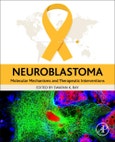Neuroblastoma: Molecular Mechanisms and Therapeutic Interventions comprehensively reviews current concepts in molecular and histopathological mechanisms that influence the growth of human malignant neuroblastoma, along with exciting therapeutic interventions. This book features a broad collection of contributions from leading investigators in histopathology, molecular mechanisms, genetics, epigenetics, microRNAs, proteomics, and metabolism in controlling growth and death in neuroblastoma. Recent developments in therapeutic interventions for neuroblastoma are also covered extensively, including chapters on surgery, chemotherapy, targeted therapy and immunotherapy. This book is ideal for advanced undergraduate students, graduate students, medical students, postdoctoral fellows, and investigators with an interest in current molecular concepts and therapeutic interventions.
Please Note: This is an On Demand product, delivery may take up to 11 working days after payment has been received.
Table of Contents
1. Neuroblastoma pathology and classification 2. Role of genetic and epigenetic alterations in pathogenesis of neuroblastoma 3. Neuroblastoma molecular biology and promising therapeutic targets 4. The GD2-targeted immunotherapy of neuroblastoma 5. Targeting angiogenesis in neuroblastoma 6. Autophagy and novel therapeutic strategies in neuroblastoma 7. Energy metabolism and new therapeutic opportunities in neuroblastoma 8. Multimodality imaging for diagnosis of neuroblastoma 9. Immunotherapy for neuroblastoma 10. Advances in surgical treatment of neuroblastoma 11. Role of stemness factors in neuroblastoma: Neuroblastoma stem cells, tumor microenvironment, and chemoresistance 12. Current pharmacotherapy for neuroblastoma 13. Current challenges in the management of neuroblastoma 14. Novel therapeutic targets in neuroblastoma 15. Current and future strategies for treatment of relapsed neuroblastoma 16. Current evidence in favor of a tumor suppressor role of Krüppel-like factor 4 in malignant neuroblastoma 17. Modulation of expression of microRNA as a therapeutic strategy in malignant neuroblastoma








